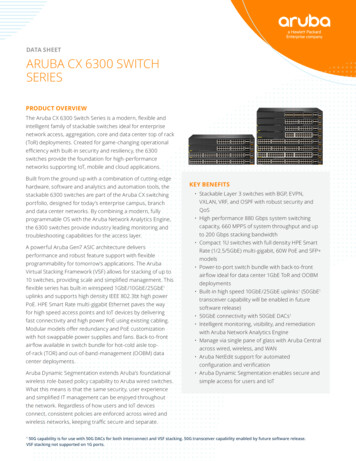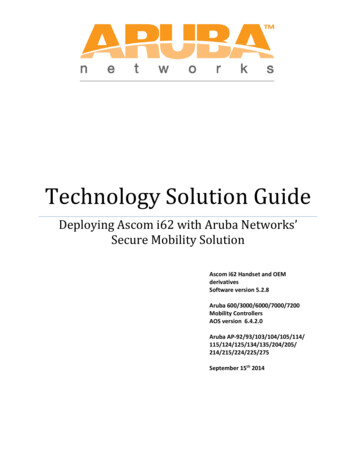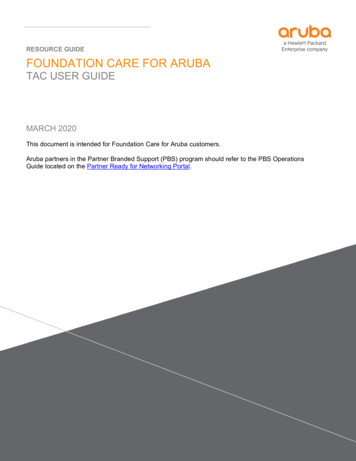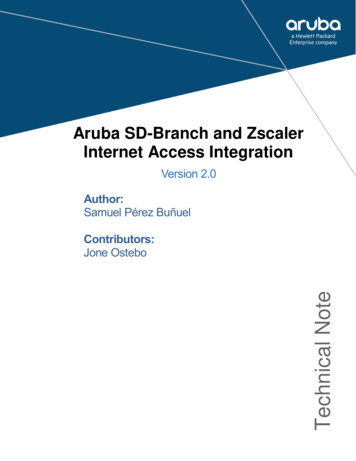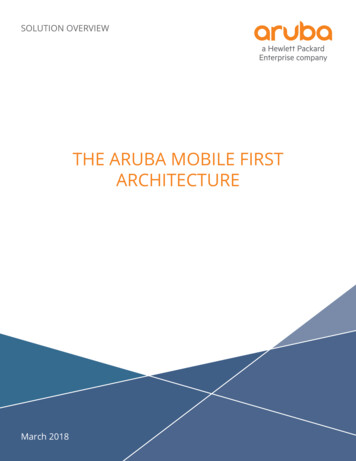
Transcription
SOLUTION OVERVIEWTHE ARUBA MOBILE FIRSTARCHITECTUREMarch 2018
Table of ContentsIntroduction.1Design.2Use Cases .2Underlay.3Overlay .3Dynamic Segmentation.3Non-Stop Networking.4Summary.5Aruba Solution Overview
IntroductionThe Aruba networking architecture for the software-defined enterprise is designed to be mobile first, and it delivers a network that is open, secure, and autonomous. The velocity, variety, and volume of users and things connecting to networks have forced IT to change the way they build and operate next-generation networks. Mobile First—Allows users and things to connect to the network and receive the same policy and permissions regardless of how they connect, wired or wireless, making them truly mobile. Purposefully designedto deliver a non-stop networking experience for environments where mobile, IoT, and cloud are missioncritical. Open—Networks are multi-vendor and need to be open. This means not only supporting open standardsbut providing rich API support in order to enable easy integration and automation end-to-end in the network by IT, line of business, and even users. Organizations need to be able to innovate at their pace and notbe locked-in and limited by a single vendor’s architecture. Secure—Security at all layers in the network is critical. Aruba secures the wired and wireless infrastructurewith signed code, secure boot, and cryptographic hardware protection. User data is protected with strongencryption and per-user level policy, both granting appropriate access and protecting devices from threats.Analytics-driven security, market leading policy management, and an extensive ecosystem of trusted security partners enables IT to design and operate their network. Autonomous—Machine learning uses massive amounts of analytics data in order to understand the operational and security state of the network. Automated systems optimize performance and alert administrators of changes or highlight potential changes that require acceptance via on-premise and cloud-managednetwork operations.Traditional networks have become a mess of VLANs and ACLs because organizations have enforced policy andsecurity on an infrastructure never designed to handle policy based on applications. Switch ports have static configurations and VLAN interfaces have hundreds, sometimes thousands of ACLs—leading to network designs thatare fragile and that IT is afraid to touch.Aruba Solution Overview1
DesignThere is not one network in the future; there are thousands, and Aruba is delivering infrastructure with a modelto support the diversity and complexity required in next-generation software-defined networks. In the softwaredefined enterprise, IT runs the infrastructure and underlay network and gives the users and line of business theability to self-provision overlay networks.USE CASES Temporary guest access to network resources—Users can create temporary guest accounts and givepermission to access network resources such as conference room video systems, printers, and Internet viaan ephemeral secured overlay. Facilities needs to allow vendor access to building IoT systems—The building manager can create asecure IoT overlay for the building control systems and provision VPN service for the vendor so they canaccess and monitor equipment. Users have devices and want own personal network—Users with multiple wired and wireless devicesneed to be able to securely onboard their devices and allow them to communicate with each other regardless of how they connect to the organization’s network.Delivering the network as a service to users is the core of software defined enterprise. BYOD and its normalization has shown that IT needs to be able to support a wide range of user devices and the avalanche of IoT devicesmeans the scale of what needs to be supported is beyond what an IT group in front of an IT management systemby themselves can handle. Tools that allow IT to delegate service creation to users based on defined privileges arenecessary to enable the enterprise and prevent a whole new wave of shadow IT.Figure 1Wired & WirelessDevicesAruba Mobile First ArchitectureManagementOverlayAccessLayerOverlay Enforces User & Device Policies App Firewall, QoS, & ShapingAIRWAVEHigh AvailabilityMobility ControllerClusterPer User/Device TunnelsNETWORKMANAGEMENTCentral Management andMonitoring for Network &Zero-Touch ProvisioningCLEARPASSLegacy DevicesSupported inUnderlayAruba Solution OverviewAccess LayerAggregation LayerUnderlayHigh PerformanceRouted UnderlayCore LayerCentral PolicyOrchestration for Wiredand Wireless Usersand Things1036AACCESSMANAGEMENT2
UNDERLAYEnterprise networks need to support the current endpoints, including many legacy systems, while they transition into a software defined model. Designs that require a full network redesign, including hardware and networkprotocol stack, can cause serious interruption and risk-compatibility issues, especially with legacy systems. MobileFirst maintains the existing routed network, using a standard interior gateway protocol (IGP), such as OSPF, as anunderlay, allowing IT to continue to run and operate existing hardware when new network is rolled out. Legacydevices can continue to operate on the underlay, and enhancements to policy allow for additional security andcontrol on the network underlay beyond what is commonly deployed in traditional networks.OVERLAYThe overlay allows organizations to safely tunnel Layer 2 or Layer 3 traffic over the top of the existing network.Aruba has been delivering wireless networks with an overlay model since the beginning, enabling IT to deliver service that would not be secure or stable otherwise across multi-vendor networks. Aruba is extending this functionality to wired networks, allowing the access layer switch to act as a “wired access point.” Network traffic from wiredand wireless users and devices is tunneled to centralized mobility controller clusters. All user and device levelpolicy can be enforced in the overlay using the mobility controller firewall, QoS, and traffic shaping and user context is easily shared to other domains. Existing VLAN and IP addresses structures can be maintained, but becausepolicy is enforced at the user and group levels, VLAN and IP address are not tied to policy.DYNAMIC SEGMENTATIONThe Aruba Mobile First Architecture does not rely on static port configurations, VLANs, or access lists on accesspoints—or access switches in the network—to apply policy to users and devices. Tunnel node—Allows an access switch to act like a “wired access point.” Users who connect to the switchcan be tunneled to the mobility controller to give the same policy and user experience as when connectedto the wireless network. For high availability, multiple tunnels are created, and if a controller needs to betaken offline for maintenance or an unplanned outage occurs, the user seamlessly fails over to a standbycontroller. Downloadable roles—If users or legacy devices connect to the wired network and need direct connectivityto the underlay, downloadable roles allow for the access port configuration to loaded dynamically based onthe user and device posture and policy. Centralized policy—Aruba ClearPass handles all users and devices connected to the network. Devices canbe profiled upon connection to the network, posture checked, and then the appropriate policy downloadedto the access port.Aruba Solution Overview3
Adaptive trust—After devices are granted access to the network, their behavior is continually monitored bybehavioral analytics tools, firewall, and IPS systems. If the security posture of the device changes, a securityanalyst can take a number of manual or automated actions such as reauthentication to verify the user,quarantining the device with limited access to network resources to allow for easy remediation, or fully isolating the device on the network while any incidents are investigated. If everything is found to be ok or thedevice is remediated the security analyst can quickly restore standard access.Aruba’s dynamic segmentation allows organizations to connect users and devices to wired ports and tunnel themto a controller or connect them to the appropriate VLAN and subnet and to download a dynamic policy (with security and QoS settings) to the port to which they are connected. This extends the functionality of traditional wired802.1X to workflows that were typically deployed only in wireless networks, such as easy onboarding by users ofunknown devices (BYOD), wired guest access with the same captive portal on the wireless network, and automated support and remediation for devices failing policy or posture checks with captive portal.NON-STOP NETWORKINGWireless is viewed as a utility level service in enterprise networks today, meaning users expect it to be always available and perform at its best. The Aruba architecture delivers a number of wired and wireless features to supportwireless networks deployed as a non-stop service with high availability an inherent part of the design. Controller Clustering—Up to 12 Aruba mobility controllers can form a high availability load-sharing clusterthat scales to hundreds of Gbps of traffic and tens of thousands of users. In-Service Upgrades—With Aruba OS 8, the wireless network is able to upgrade software on access pointsand controllers in a manner that is transparent to users on the wireless network. Users are gracefullysteered off select APs and controllers while they are upgraded and then seamlessly added back into thenetwork. Seamless Failover—Access points connect to multiple controllers in a cluster, and in the event of a failurewith the primary controller, the access points switch to the secondary with no noticeable interruption to theuser. Non-Stop Switching—Aruba OS-CX in the core and aggregation layers of the network delivers high availability and hitless upgrades, allowing IT to service the network without taking an outage.Together these features allow an Aruba network to deliver wireless that can run non-stop in an organization’s network. The network can be upgraded while users are connected, with no interruption. And because of best-in-classhigh availability, the network can handle access point and controller failures without users experiencing interruption.Aruba Solution Overview4
SummaryThe Aruba Mobile First Architecture allows organizations to gracefully transition their existing network to a software-defined enterprise, enabling new features and functionality while supporting legacy systems. An open, multivendor network infrastructure allows organizations to innovate at their pace and not become locked-in to a singlevendor solution but also leverage their existing investments. Security built in at all layers in the network protectsinfrastructure, users, and devices from existing and emerging threats from the outside and inside. Intelligent useof analytics by administrators and machine-learning based automation provides network assurance and beginsthe shift to a “self driving” network where IT maintains the infrastructure and policy and users provision servicesdynamically.Aruba Solution Overview5
2018 Aruba Networks, Inc. All rights reserved. Aruba Networks and the Aruba logo are registered trademarksof Aruba Networks, Inc. Third-party trademarks mentioned are the property of their respective owners. To viewthe end-user software agreement, go to www.arubanetworks.com/assets/legal/EULA.pdfYou can use the feedback form to send suggestions andcomments about this solution overview.B-000110A-1 03/18
The Aruba networking architecture for the software-defined enterprise is designed to be mobile first, and it deliv-ers a network that is open, secure, and autonomous. The velocity, variety, and volume of users and things con-necting to networks have forced IT to change the way they build and operate next-generation networks.





